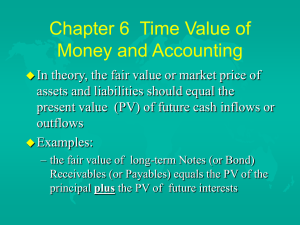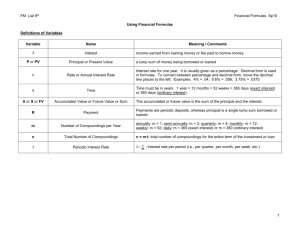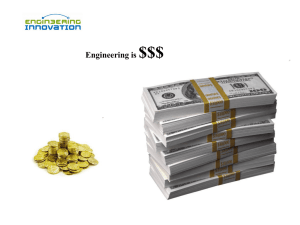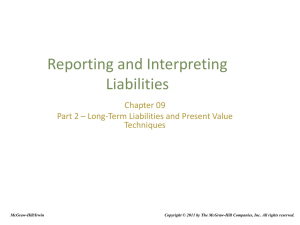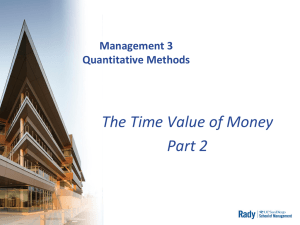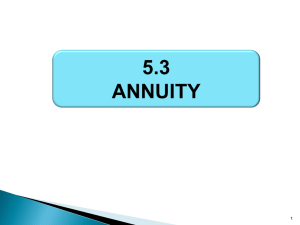1campv
advertisement
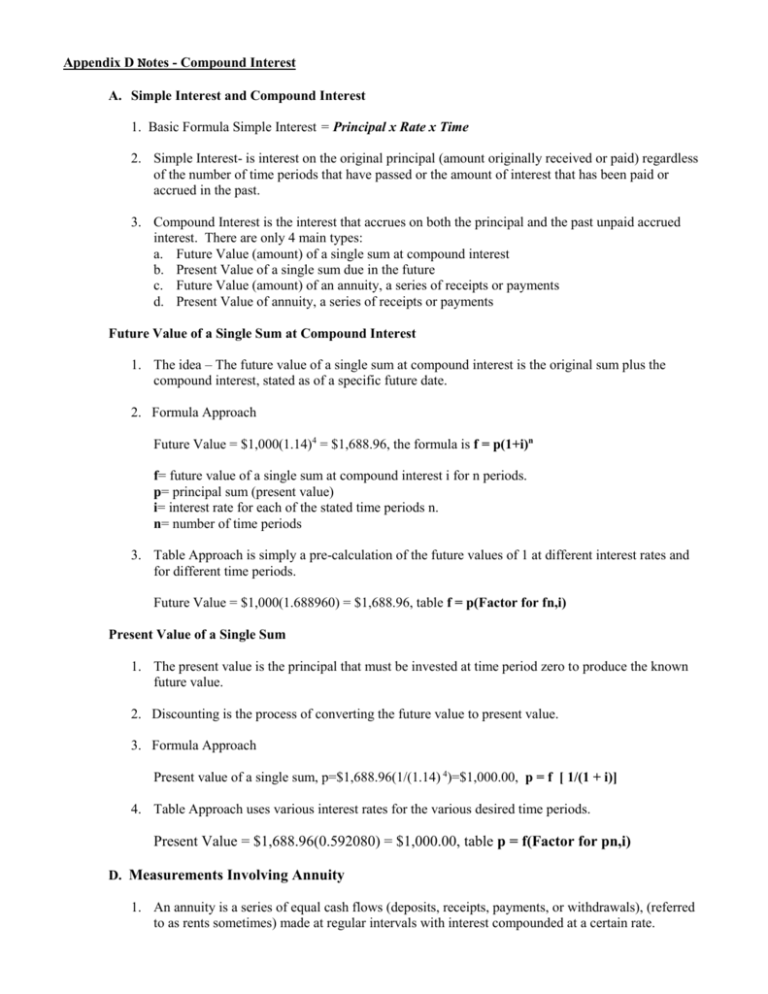
Appendix D Notes - Compound Interest A. Simple Interest and Compound Interest 1. Basic Formula Simple Interest = Principal x Rate x Time 2. Simple Interest- is interest on the original principal (amount originally received or paid) regardless of the number of time periods that have passed or the amount of interest that has been paid or accrued in the past. 3. Compound Interest is the interest that accrues on both the principal and the past unpaid accrued interest. There are only 4 main types: a. Future Value (amount) of a single sum at compound interest b. Present Value of a single sum due in the future c. Future Value (amount) of an annuity, a series of receipts or payments d. Present Value of annuity, a series of receipts or payments Future Value of a Single Sum at Compound Interest 1. The idea – The future value of a single sum at compound interest is the original sum plus the compound interest, stated as of a specific future date. 2. Formula Approach Future Value = $1,000(1.14)4 = $1,688.96, the formula is f = p(1+i)n f= future value of a single sum at compound interest i for n periods. p= principal sum (present value) i= interest rate for each of the stated time periods n. n= number of time periods 3. Table Approach is simply a pre-calculation of the future values of 1 at different interest rates and for different time periods. Future Value = $1,000(1.688960) = $1,688.96, table f = p(Factor for fn,i) Present Value of a Single Sum 1. The present value is the principal that must be invested at time period zero to produce the known future value. 2. Discounting is the process of converting the future value to present value. 3. Formula Approach Present value of a single sum, p=$1,688.96(1/(1.14) 4)=$1,000.00, p = f [ 1/(1 + i)] 4. Table Approach uses various interest rates for the various desired time periods. Present Value = $1,688.96(0.592080) = $1,000.00, table p = f(Factor for pn,i) D. Measurements Involving Annuity 1. An annuity is a series of equal cash flows (deposits, receipts, payments, or withdrawals), (referred to as rents sometimes) made at regular intervals with interest compounded at a certain rate. E. Future Value of an Ordinary Annuity 1. The future value of an ordinary annuity is determined immediately after the last cash flow in the series is made. Drawing a time line adds a beginning time segment to the left of the time when the first cash flow occurs. 2. Formula Approach Future Value of an ordinary annuity = $1000.00[(1.14) 4 -1/0.14] = $4,291.14, the formula is Fo= C [(1+i)n-1/i] Fo= future value of an ordinary annuity of a series of cash flows of any amount C= amount of each cash flow n= number of cash flows i= interest rate for each time period 3. Table Approach Future Value of an ordinary annuity = $1000.00(4.921144) = $4,291.14, the table is Fo= C (Factor for Fo n,i) F. Future Value of an Annuity Due 1. The future value of an annuity due is determined 1 period after the last cash flow in the series. 2. Solution Approach a. In the ordinary annuity table (Table 2), look up the value of n + 1 cash flows at 14% or the value of 5 cash flows at 14%. b. Then subtract 1 without interest from the value obtained in step 1. = 6.610104 =(1.000000) c. Multiply the amount of each cash flow, here $1,000, by the converted factor for Fd = $1,000(5.610104) = $5,610.10 d. The general rule is to use the future value of an ordinary annuity for n+1 cash flows and subtract 1 from the factor. G. Present Value of an Annuity 1. The present value of an annuity is the present value of a series of equal cash flows that occur in the future. Overtime, the present value balance is increased periodically for interest and is decreased periodically for each receipt or payment. Thus, the last cash flow will exhaust all funds. H. Present Value of an Ordinary Annuity 1. The present value of an ordinary annuity is determined 1 period before the first cash flow in the series is made. 2. Formula Approach Present Value of an ordinary annuity is Po = $1,000.00[ 1- (1/1.14)4 /0.14] = $2,913.71, the formula is Po = C [ 1- (1/1+i)n /i] Po= present value of an ordinary annuity of a series of cash flows of any amount C= amount of each cash flow n= number of cash flows (not the number of time periods) i= interest rate for each time period 3. Table Approach Present Value of an ordinary annuity = $1000.00(2.913712) = $2,913.71, the table is Po= C (Factor for Po n,i) I. Present Value of an Annuity Due 1. The present value of an annuity due (Pd) is determined on the date of the first cash flow in series. 2. Formula Approach Present Value of an annuity due is Pd = $1,000.00[ (1- (1/1.14)3 /0.14) +1] = $3,321.63, the formula is Pd = C [ (1- (1/1+i)n-1 /i ) +1] Pd= present value of an ordinary annuity of a series of cash flows of any amount C= amount of each cash flow n= number of cash flows (not the number of time periods) i= interest rate for each time period 3. Table Approach a. In the ordinary annuity table (Table 4), look up the present value of n - 1 cash flows at 14% or the value of 3 cash flows at 14%. b. Then add 1 without interest from the value obtained in step 1. c. Multiply the amount of each cash flow, here $1,000, by the converted factor for Pd = $1,000 (3.321632) d. The general rule is to use the present value of an ordinary annuity for n-1 cash flows and add 1 to the factor =2.321632 =1.000000 = 3.321632 J. Present Value of a Deferred Ordinary Annuity The present value of a deferred ordinary annuity (Pdeferred) is determined on a date 2 or more periods before the first cash flow in the series. For Example: Pdeferred = C [(Po n=4, i=14%)(Pk=3, i=14%) … k= periods of deferment = $1,000 [(2.913712)(.674972)] = $1,966.67 K. Conceptual Evaluation of Present Value Techniques in Financial Reporting Present Values are used in generally accepted accounting principles for certain monetary items. A monetary item is money or a claim to money that is not affected by the changes in prices of specific goods or services. In 1998, the FASB issued FASB Proposed Statement of Concepts, “Using Cash Flow Information in Accounting Measurements.” The Proposed Statement identifies four general principles that govern measurements involving present value: (1) the cash flows should consider all relevant future events and uncertainties, (2) the assumptions used to select interest rates should be consistent with the assumptions inherent in the estimated cash flow amounts, (3) the estimated cash flows and interest rates should be free from bias and unrelated factors, and (4) the estimated cash flows or interest rates should reflect the range of possible cash flows rather than a single most likely, minimum, or maximum possible amount.



